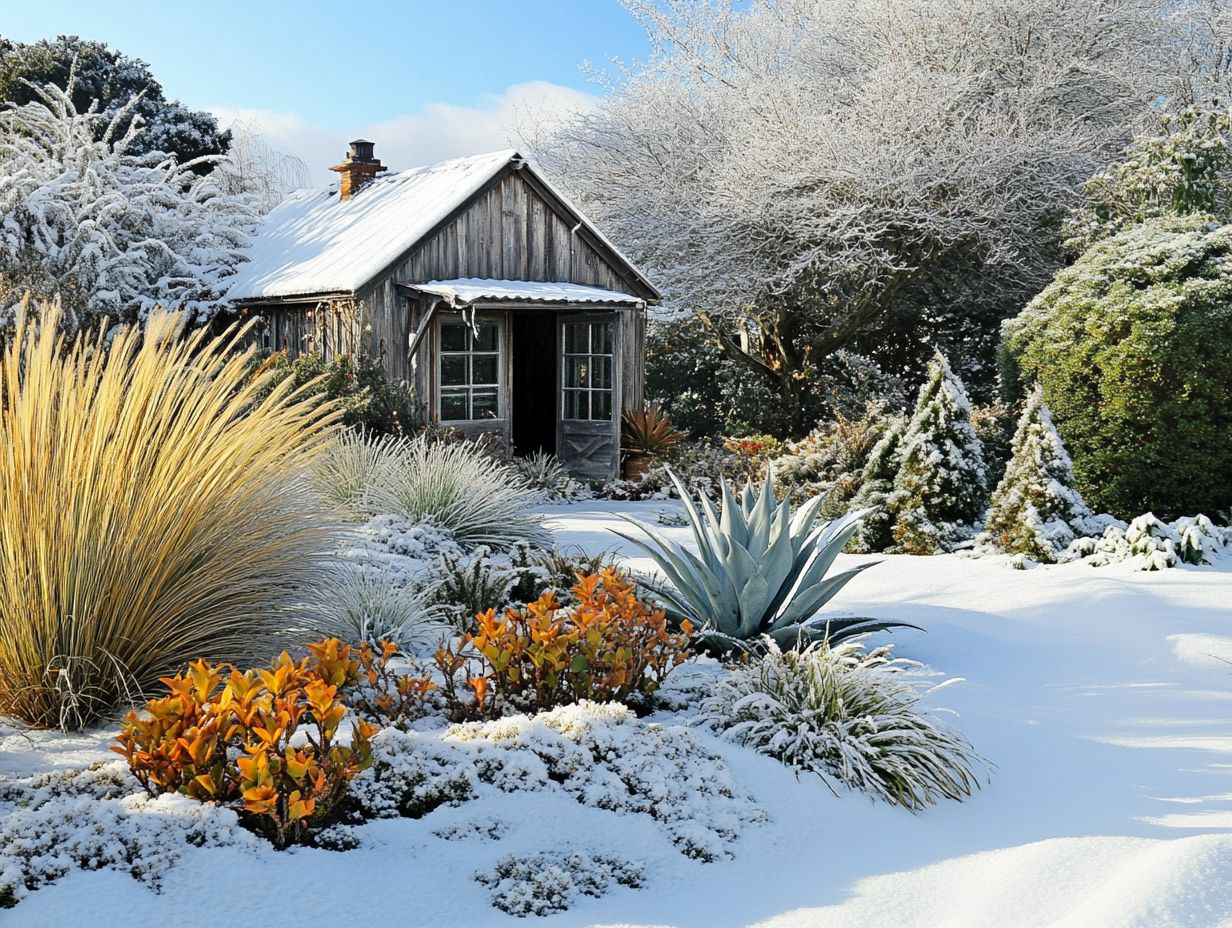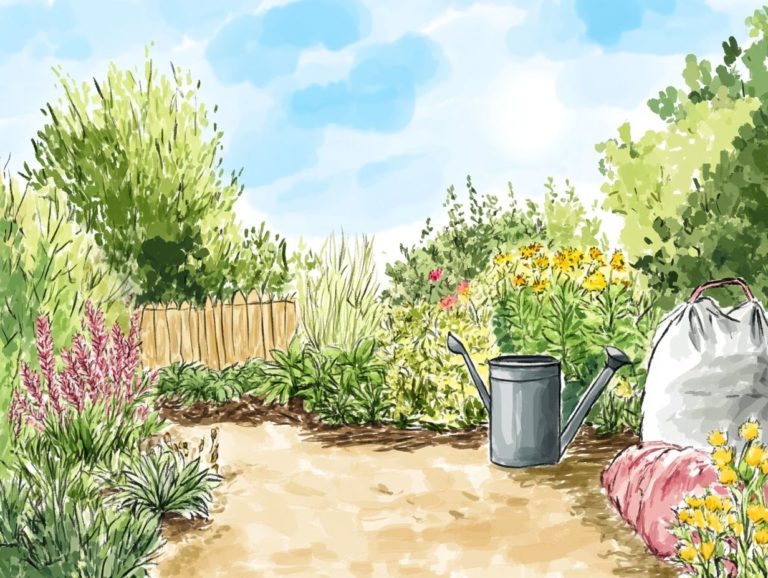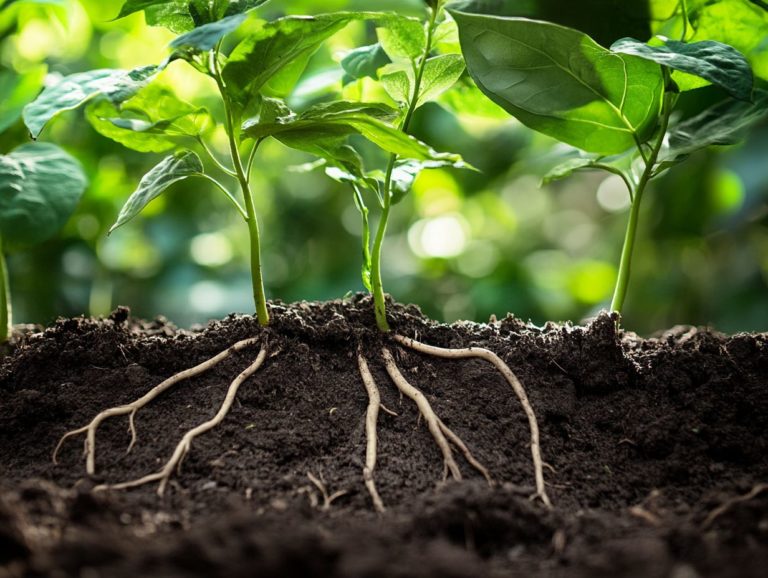Winter Care for Drought-Resistant Plants
Drought-tolerant plants are an excellent choice for cultivating a resilient garden that thrives even in challenging conditions. As winter draws near, it s crucial now to prepare and care for these hardy plants, ensuring their flourishing come spring.
This guide will walk you through essential pre-winter maintenance, effective methods for protecting your plants from the cold, and tips for identifying potential pests and diseases. With the right knowledge and practices, you can empower your drought-resistant garden not just to survive, but to truly thrive throughout the winter months.
Let s dive into proven tips to keep your plants thriving!
Contents
- Key Takeaways:
- Preparing Drought-Resistant Plants for Winter
- Winter Care for Drought-Resistant Plants
- Common Winter Pests and Diseases
- Reviving Drought-Resistant Plants in Spring
- Tips for Choosing and Maintaining Drought-Resistant Plants
- Factors to Consider and Best Practices
- Frequently Asked Questions
- Why is winter care important for drought-resistant plants?
- How often should I water my drought-resistant plants during winter?
- Do I need to fertilize my drought-resistant plants during winter?
- How can I protect my drought-resistant plants from frost during winter?
- Should I prune my drought-resistant plants in winter?
- Can I plant new drought-resistant plants during winter?
Key Takeaways:

- Proper pre-winter maintenance and care are essential for the health and survival of drought-resistant plants during the colder months.
- Protecting plants from cold and frost while providing adequate watering and nutrients are crucial for winter care.
- Understanding and treating common winter pests and diseases, along with following post-winter care tips, can help revive drought-resistant plants in the spring.
What are Drought-Resistant Plants?
Drought-resistant plants are your go-to allies for thriving in drought conditions with minimal water. They re essential for sustainable gardening, especially in regions grappling with the impacts of climate change.
These remarkable species have a knack for adaptation, sporting fleshy leaves and reflective coatings that work to minimize water loss. But their benefits go beyond mere survival; incorporating these drought-tolerant varieties into your landscaping not only boosts biodiversity but also builds resilience against extreme weather.
Consider popular choices like Lavender, with its delightful fragrance, and Sedum, featuring its unique, stone-like leaves. They effortlessly enhance your garden s beauty while playing a vital ecological role. These plants provide food and shelter for beneficial insects, enriching your garden ecosystem, all while cutting down on maintenance and irrigation costs.
Ultimately, choosing such plants supports water conservation and nurtures a harmonious relationship with the environment.
Preparing Drought-Resistant Plants for Winter
Preparing drought-resistant plants for winter is essential for their survival through the cold and frosty months. These plants require a unique approach that sets them apart from traditional gardening practices.
To ensure their well-being, you should assess the soil health and employ deep watering techniques before the frost arrives. This method enhances moisture retention, which is vital for their resilience.
Using organic materials like mulch serves a dual purpose: it safeguards the root system while helping to maintain optimal moisture levels. This thoughtful preparation supports the overall health of your plants as they transition into their resting state and enhances their resilience against dry conditions.
Pre-Winter Maintenance and Care
Proper pre-winter maintenance and care for your drought-tolerant plants involve a thoughtful approach to safeguard them from harsh winter conditions while also promoting their overall health through appropriate garden design.
Start by applying organic mulch around the base of your plants; this not only suppresses pesky weeds but also retains moisture. Take a moment to assess your plants conditions and implement strategies that bolster their resilience against the cold.
As winter approaches, adjusting your watering schedule becomes essential. Reducing water intake prevents root rot and helps your plants adapt to drier conditions. Regularly assessing your plants health is equally important; keep an eye out for any signs of stress or disease so you can act swiftly.
Additionally, ensure proper drainage around your plants to effectively manage moisture levels excess water during winter can lead to serious issues. By combining these maintenance practices, you ll cultivate robust, drought-tolerant varieties that can bravely face the chill of winter while enhancing your landscape design.
Winter Care for Drought-Resistant Plants
Caring for drought-resistant plants during winter is crucial to protect them from the cold and frost. This ensures they thrive come spring while providing a habitat for beneficial pollinators. Consider implementing protective measures like organic mulch or fabric covers to shield delicate foliage from harsh temperatures.
Maintaining consistent irrigation during milder winter days is key to sustaining moisture levels in the soil. This practice nurtures healthy root systems, essential for the plants’ survival.
Protecting Plants from Cold and Frost

Did you know that protecting drought-resistant plants from biting cold and frost is essential for their survival? This requires careful planning and execution on your part. Techniques like wrapping them in frost cloth or utilizing windbreaks can significantly lessen the impact of harsh weather.
It’s important to meet their watering needs during milder winter days. This helps maintain optimal soil hydration. By taking proactive measures, you can cultivate a thriving garden come spring.
Moreover, strategically positioning these plants in your landscape can bolster their frost resistance. Placing them in sheltered spots, near walls or larger shrubs, offers added protection from icy winds.
Keeping an eye on temperature fluctuations is vital. This awareness enables you to make timely adjustments, such as covering your plants during unexpected cold snaps.
Knowing how to water your plants in winter can make a big difference. Overwatering can lead to root rot, a condition where roots decay due to too much water, while under-watering may stress them, making them more susceptible to frost damage.
Watering and Nutrient Needs
Understanding the watering and nutrient needs of drought-resistant plants is essential for their survival, especially during winter when their requirements shift. Effective water management is crucial. These plants generally demand less water than traditional varieties.
Ensure they receive adequate moisture during warmer spells by utilizing water-efficient practices. Incorporating organic mulch can enhance soil health by providing vital nutrients and improving moisture retention, thus supporting the plants throughout their dormant phase.
Regularly assess moisture levels and adjust your watering schedule accordingly. During dry spells, consider slightly increasing the watering frequency, while in cooler months, reducing it can help prevent root rot. Nutrient needs can vary, so using a balanced organic fertilizer can bolster their health without compromising their low-water requirements.
Organic mulch acts as a protective barrier against temperature fluctuations and weed growth, insulating the plants roots effectively. By adapting your care routines to seasonal changes and monitoring the specific drought-resistant species in your garden, you can create a thriving environment that supports local native vegetation, even if you re a novice gardener.
Common Winter Pests and Diseases
Did you know pests like aphids can threaten your garden in winter? Common winter pests and diseases can present serious challenges to your drought-resistant plants. It’s imperative to remain vigilant and proactive in maintaining their soil health.
By identifying potential issues early whether it s pesky aphids or troublesome fungal diseases you can intervene promptly to protect your plant’s health. This ensures a flourishing growing season while practicing effective weed control.
Embracing environmentally friendly treatment strategies not only supports sustainable gardening practices but also reinforces the resilience of your garden, allowing it to thrive even in the face of adversity.
Start preparing your garden now to enjoy a vibrant spring!
Identifying and Treating Pests and Diseases
Identifying and treating pests and diseases in your drought-resistant plants requires careful observation and basic knowledge of the common issues that arise during winter. Look out for signs like discolored leaves or uninvited insects. Diseases can be recognized through unsightly spots or wilting foliage.
By utilizing organic materials and treatments, you can effectively manage these challenges while maintaining your commitment to water conservation and sustainable gardening practices.
You ll benefit immensely from closely monitoring your plants and conducting regular inspections to catch problems early on. Having guides on specific pests, such as aphids or spider mites, can help you quickly diagnose and address any outbreaks.
For instance, invite ladybugs into your garden for effective pest control. Plus, incorporating organic solutions like neem oil or insecticidal soap promotes plant health without compromising the environment.
Maintaining overall garden care like ensuring the soil is healthy and watering appropriately will fortify your plants against threats, ultimately fostering a vibrant and resilient garden ecosystem.
Reviving Drought-Resistant Plants in Spring
Reviving drought-tolerant plants in spring is a rewarding endeavor that requires attention to their unique needs as they awaken from dormancy.
Begin by assessing the moisture levels to ensure these resilient plants receive sufficient watering to kickstart their growth. Integrating smart garden designs will enhance plant vitality and create a vibrant landscape that withstands the summer heat.
Post-Winter Maintenance and Care

Post-winter maintenance and care are essential for your drought-resistant plants, like Lavender and Sedum, as they shift from dormancy to vibrant growth in the spring. Implement irrigation practices that cater specifically to the plants’ needs, ensuring they receive the perfect amount of hydration without the risk of overwatering.
Enhancing soil health with organic materials and mulch will provide the crucial nutrients your plants need to thrive as temperatures rise.
Timing is critical for fertilization and deep watering; applying nutrients too early can lead to wasted resources and may harm your plants. Observe the signs of growth before introducing fertilizers, allowing you to adjust based on the unique responses of different plant species.
Regularly monitoring moisture levels and understanding local climate impacts on plant establishment can profoundly influence the success of these resilient varieties, including native plants and plants adapted to dry environments. By prioritizing these practices, you’ll create an environment that encourages healthy growth and sustainable gardening, preparing your plants for the warmth ahead.
Tips for Choosing and Maintaining Drought-Resistant Plants
Choosing and maintaining drought-resistant plants requires careful thought and a solid grasp of your local conditions, along with the options available at your nearby nursery.
Selecting species that are well-suited to your local climate and soil health can greatly enhance your garden’s sustainability and resilience in the face of drought.
Regular maintenance for weed control is essential and will not only help these plants flourish but also promote water conservation and bolster the overall health of your garden.
Factors to Consider and Best Practices
When choosing drought-resistant plants, several factors ensure your garden thrives sustainably. Consider the local climate, soil conditions that affect soil health and erosion, and the specific needs of different plant species.
Best practices for sustainable gardening include:
- Using organic mulch, which helps retain moisture.
- Implementing efficient watering methods, such as automatic sprinklers.
- Regularly monitoring plant health and adaptations to drought conditions to cultivate a thriving ecosystem.
Keep in mind, certain drought-resistant plants are better suited for specific climates. For instance, plants like lavender and agave excel in arid environments, while sedum flourishes in more moderate conditions.
Soil health is crucial. Amended soil with water-holding polymers can significantly boost water retention and nutrient availability, creating a welcoming environment for these resilient plants.
Incorporating techniques like rainwater harvesting for efficient water management and water-conserving landscaping can further enhance water efficiency. By selecting plants that align with your local climate and soil type, you not only promote sustainability but also conserve resources, ensuring your garden flourishes even in the face of water scarcity and environmental challenges.
Frequently Asked Questions
Why is winter care important for drought-resistant plants?
Even though these plants are naturally adapted to survive in dry conditions, they still need care during the winter months to ensure their health and growth in the following season. Proper winter care helps these plants maintain their resilience and vigor.
How often should I water my drought-resistant plants during winter?

Drought-resistant plants still need water, even during winter. However, they require less frequent watering compared to other plants. Water them every 2-3 weeks if there is no rainfall, but ensure the soil is well-drained to prevent root rot.
Do I need to fertilize my drought-resistant plants during winter?
No, it is not necessary to fertilize your drought-resistant plants during winter. These plants thrive in nutrient-poor soil, so they do not need extra fertilization. In fact, applying fertilizer during winter when the plants are dormant can do more harm than good.
How can I protect my drought-resistant plants from frost during winter?
Most drought-resistant plants are hardy and can tolerate light frosts. However, if you live in an area with severe winter temperatures, you can protect your plants by covering them with a layer of mulch or a frost cloth. Be sure to remove the coverings during the day to allow air circulation.
Should I prune my drought-resistant plants in winter?
In general, it’s best to avoid pruning in winter as this can stimulate new growth that is vulnerable to cold temperatures. However, if your drought-resistant plant has dead, damaged, or diseased branches, you can prune them to promote new growth in the spring.
Can I plant new drought-resistant plants during winter?
It’s not recommended to plant new drought-resistant plants during winter. Plant your drought-resistant beauties in spring or fall for the best results, when the weather is mild and there is enough time for them to establish their root systems before harsh winter conditions arrive.






